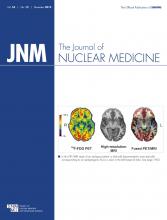In vivo tracking of cellular therapy: Aarntzen and colleagues review recent innovations in transplantation of living cells that advance regeneration of damaged tissue, replace function, and redirect aberrant processesPage 1825

PET/CT and MTV in myeloma: Fonti and colleagues report on whether metabolic tumor volume as determined by 18F-FDG PET/CT can be used to predict progression-free and overall survival in patients with multiple myeloma.Page 1829
PET and MEK inhibition: Kraeber-Bodéré and colleagues use 18F-FDG PET to assess 2 mitogen-activated protein kinase kinase inhibitors in separate trials to show the potential of metabolic imaging for dose considerations, compound selection, and response prediction in early trials.Page 1836
PET/CT meta-analysis: Xu and colleagues offer a systematic review and analysis of the performance of whole-body PET/CT for detection of distant malignancies in various cancers.Page 1847
Thyroid uptake in breast cancer: Kim and colleagues explore the prognostic value of incidental diffuse thyroid 18F-FDG uptake related to autoimmune thyroiditis in PET imaging in patients with breast cancer.Page 1855

18F-FDG and 18F-DOPA PET in MTC: Verbeek and colleagues compare these 2 PET tracers with biochemical parameters and survival in patients with medullary thyroid carcinoma to assess potential utility in detecting progressive disease.Page 1863

Integrin imaging in DTC: Zhao and colleagues evaluate integrin αvβ3 imaging in the detection of radioactive iodine–refractory differentiated thyroid cancer lesions and resultant identification of feasible antiangiogenic therapeutic targets.Page 1872
Segmentation-based AC in PET/MRI: Kim and colleagues analyze potential bias in standardized uptake value estimation using 4 different segmentation-based attenuation correction methods on data from cancer patients with bone and liver lesions.Page 1878
18F-DCFBC tumor detection and dosimetry: Cho and colleagues describe initial clinical experiences with and radiation dosimetry of this PET tracer, a low-molecular-weight, urea-based inhibitor of prostate-specific membrane antigen, in men with prostate cancer.Page 1883

Gating error and cardiac dyssynchrony: Ludwig and colleagues examine the incidence and effect of gating errors on SPECT quantification of left ventricular mechanical dyssynchrony and test a possible solution for affected studies.Page 1892
Performance of high-sensitivity cameras: Imbert and colleagues analyze both phantom and human images to compare the performance of 3 cadmium-zinc-telluride cameras/collimation systems recently commercialized for myocardial SPECT.Page 1897
18F-FLT PET and survival in glioma: Idema and colleagues assess various 18F-FLT PET segmentation methods to estimate proliferative volume and its prognostic value for overall survival in patients with suspected high-grade glioma.Page 1904

18F-FLT PET in glioma: Yamamoto and colleagues evaluate 18F-FLT uptake on PET in patients with newly diagnosed and recurrent gliomas and correlate the results with tumor grade and proliferative activity.Page 1911
PET/MRI for neurologic applications: Catana and colleagues provide an educational overview of methodologic improvements in hybrid PET/MRI and discuss potential neurologic and psychiatric applications.Page 1916
Pretargeted immuno-SPECT: Schoffelen and colleagues describe the use of pretargeted immuno-SPECT with TF2 and 111In- or 177Lu-IMP288 to predict and confirm tumor targeting and monitor the therapeutic effect of radioimmunotherapy.Page 1926

Imaging radiovirotherapy: Haddad and colleagues assess the feasibility and parameters of serial imaging and long-term monitoring of virotherapy and response of pancreatic cancer xenografts treated with a vaccinia virus carrying the human sodium iodide symporter GLV-1h153.Page 1933
HER2–HER3 bispecific radioimmunoconjugates: Razumienko and colleagues construct agents and use SPECT/CT to evaluate tumor imaging in athymic mice that express one or both human epidermal growth factor receptors.Page 1943
Matched terbium radionuclide quadruplet: Müller and colleagues describe a proof-of-concept study designed to produce 4 terbium radioisotopes and assess their diagnostic and therapeutic features in vivo when labeled with a folate-based targeting agent.Page 1951
GLP-1R PET in myocardial ischemia: Gao and colleagues use noninvasive PET to monitor the presence and time course of regional myocardial glucagonlike peptide 1 receptor expression after myocardial ischemia or reperfusion.Page 1960
123I-5I-R91150 SPECT after morphine: Adriaens and colleagues use SPECT and a radiolabeled 5-HT2A radioligand to assess the influence of systemic morphine on cerebral 5-hydroxytryptamine receptor 2A binding in dogs.Page 1969
GABAA receptor density in epilepsy: Syvänen and colleagues investigate whether flumazenil blood–brain barrier transport and binding to the benzodiazepine site on the γ-aminobutyric acid A receptor complex is altered in epilepsy and explore implications for 11C-flumazenil PET interpretationPage 1974
Hyperoxic lung injury imaging: Clough and colleagues describe changes in lung uptake of 99mTc-HMPAO and 99mTc-duramycin, a new marker of cell injury, in rats exposed to hyperoxia for prolonged periodsPage 1984
ON THE COVER

In this PET/MRI study of an epilepsy patient, a distinctly hypometabolic area typically corresponding to an epileptogenic focus is seen in the left temporal lobe.
See page 1923.
- © 2012 by the Society of Nuclear Medicine and Molecular Imaging, Inc.







